
Constellation Guide: Cassiopeia
Last updated: 23 October 2009
"GO TO"....CASSIOPEIA - A Slightly Naughty and Precocious Celestial Queen
....some people see it as an "upside down W"....I see it as an "M"
[Mike here: Either way, a guy known as "Mike Weasner" is happy with the orientation!]
From: Clay Sherrod (drclay@tcworks.net)
In this 26th Constellation Guide, "GO TO CASSIOPEIA" of the series "GO TO GUIDES for the ETX, LX 90 and all GO TO Telescope Users we will explore the pre-fall skies that serve as a precursor to impending crisp evening skies, the smells of browning leaves as Mother Nature prepares its trees for the crunch of winter cold.
Cassiopeia is one of the few CIRCUMPOLAR CONSTELLATIONS for the northern hemisphere in that it truly never rises nor sets below any horizon from as far south as 30 degrees north. Rather, it appears - if you were able to observe it throughout its 24-hour spin - to describe a complete circle centered on the North Star, Polaris. Note from my following diagram the positions of Cassiopeia as seen at 10 p.m. your local time on four times of year:
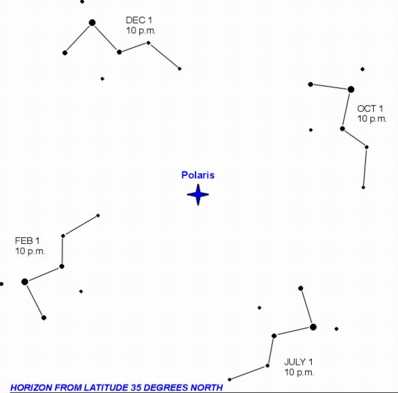
NOW....look at its changing positions throughout the course of a winter evening, from 6 p.m. through 6 a.m. local time:
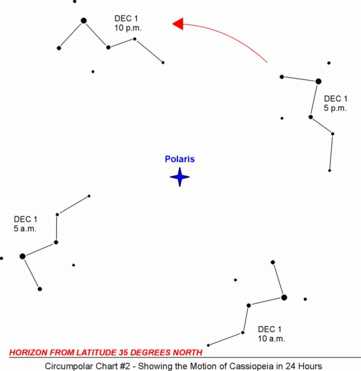
Through this constellation, perhaps even better than "the big dipper" in Ursa Major can we witness the rotation of the Earth through the course of the night as its geographical axis is pointing directly toward the central point of this great circle inscribed by the large "W" or "M" shaped asterism of the sky. Note that on midnight on or about April 10 each year, middle northern latitude observers will spot Cassiopeia very low on the northern horizon "below" Polaris; at this point the asterism describes a clear "W" shape; however, a half-year later we wind the same constellation also at midnight much higher in the sky "above" Polaris and turned "upside down" to form a distinct "M" shape on about October 10.
Cassiopeia is a familiar constellation to even the most casual skygazer, its primary bright stars (see below) describing that familiar "W" shape (Or an "M" is you are of that persuasion) in the high northern sky. The photograph below demonstrates the primary stars, marked with their Bayer designations, of the constellation:
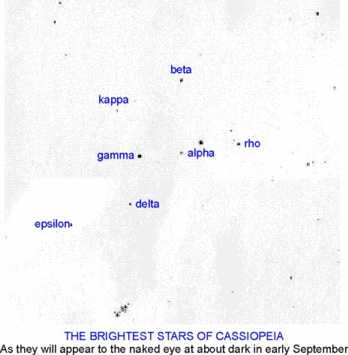
I have written much about the questionable carrying-ons of Queen Cassiopeia (wife of Cepheus) In Ethiopian, Arabic and Greek lore/ The daughter of Cassiopeia and Cepheus (see http://www.weasner.com/etx/ref_guides/andromeda.html ) was the princess Andromeda who was left to be devoured by the great sea monster CETUS (http://www.weasner.com/etx/ref_guides/cetus.html by none other than mum and dad when their kingdom and subjects were about to fall victim to the wrath of the Gods of the Sea. . In addition to this dysfunctional family atrocity, the mother (Cassiopeia) was so vain that she bragged to all around her as more beautiful than the prized daughters of Nereus, one of the many gods of the sea.
Rumor has it - as told "Here First....only in the Enquirer...." that Cassiopeia was also unfaithful to her King husband Cepheus, philandering it seems with the muscular ("...it's not buttuh....") hero Perseus - although all the king's horses and all the king's men could never get their surveillance cameras to get the goods on the unfaithful spouse. So at least for her incessant vanity, Cassiopeia was destined to suffer the revenge of the god Poseidon by chaining her daughter, Andromeda to a rock a on a cragged rocky coast as a sacrifice for a sea monster, now enshrined as the constellation CETUS (now configured in more peaceful and "happy" images as a mere "whale"). But Andromeda was, alas, saved from certain "sea monster death" by the hero, Perseus. After rescuing her he demanded Andromeda as his wife (which Cepheus gladly accepted...he came out a winner for both mother and daughter it seems! We have no late-breaking news as to the opinion of all this father-daughter bartering in the opinion of the lovely - but jilted - Cassiopeia.
So....however you might interpret this somewhat culturally conflicting story of the Peyton Place of the immortals, one fact about Cassiopeia remains intact in all cultural legends of her demise, either from
1) infidelity to Cepheus through the likes of the handsome "...it's not buttahh" Perseus; or,
2) her vanity that insulted all the gorgeous nymphs of the sea (known today as the "Swedish Bikini Team")
....the forlorn Queen has forever been banished to the sky encircle upside down forever, tethered to her once-royal throne. It is this "throne" that we see today as inscribed by the "W" shape (I can clearly see a "Shaker-style" four-post chair myself), and I have, for the likes of me, never been able to see that gorgeous figure of a woman we know as "Cassiopeia."
Cassiopeia (pronounced "cass-eo-PEA-a") is up all night for most observers in the northern hemisphere. It is at its "lowest" (closest to the north horizon) point at midnight on April 8 each year, with all of its size (6) brightest stars of the "chair" barely being seen as they spin under Polaris against the horizon at 35 degrees north latitude. Conversely, the conspicuous "W" shape is highest in the sky on about October 8 at midnight every year (midnight culmination). An interesting note about this circumpolar motion of Cassiopeia is that you will quickly realize that this conspicuous asterism of stars is ALWAYS nearly exactly opposite of the "little dipper" of the constellation Ursa Minor.
--------------------------------
THE STARS OF CASSIOPEIA -
**NOTE: Listed below are the primary (all Greek alphabet ["Flamsteed"]) naked eye stars which comprise Cassiopeia. For reference, the Smithsonian Astrophysical Observatory (SAO) number is also provided, followed by the visual magnitude and spectral type of each star.
Bayer/Flamsteed SAO MAG R.A. & DEC (2000) Alpha 18 SHEDIR 21609 2.23 K0IIIa 00 40 30.465 + 56 32 beta 11 CAPH 21133 2.27 F2III 00 9 10.719 + 59 08 gamma 27 MARJ/Cih 11482 2.47 & 2.3 B0IVe 00 56 42.514 + 60 43 delta 37 RUCHBAH 2226 2.68 A5III-IV 01 25 48.986 + 60 14 epsilon 45 SEGIN 12031 3.38 B3III 01 54 23.71 + 63 40 zeta 17 21566 3.66 B2IV 00 36 58.297 + 53 53 eta 24 ACHIRD 21732 3.44 & 11.6 F9V+dM0 00 49 6.04 + 57 48 theta 33 MARFAK 22070 4.33 A7V 01 11 6.183 + 55 08 iota 12298 4.52 A5pSr 02 29 3.97 + 67 24 kappa 15 11256 4.16 B1Ia 00 32 59.965 + 62 55 lambda 14 21489 4.73 0.5 B8Vn 00 31 46.411 + 54 31 mu 30 MARFAK 22024 5.17 G5Vb 01 8 16.36 + 54 55 nu 25 21729 4.89 B9III 00 48 50.06 + 50 58 xi 19 21637 4.8 B2V 00 42 3.899 + 50 30 omicron 22 36620 4.54 B5IIIe 00 44 43.532 + 48 17 pi 20 36602 4.94 A5V 00 43 28.113 + 47 01 rho 7 35879 4.54 G20e 23 54 23.05 + 57 29 sigma 8 35947 4.88 & 2.8 B1V 23 59 0.532 + 55 45 tau 5 35763 4.87 K1IIIa 23 47 3.528 + 58 39 upsilon1 26 21832 4.83 K2III 00 55 0.125 + 58 58 upsilon2 28 21855 4.63 G8IIIbFe-0.5 00 56 39.82 + 59 10 phi 34 22191 4.98 133.8 F0Ia 01 20 4.908 + 58 13 chi 39 22397 4.71 G9IIIb 01 33 55.928 + 59 13 psi 36 11751 4.74 23.2 K0III 01 25 56.034 + 68 07 omega 46 12038 4.99 B8III 01 55 59.947 + 68 41
For a very comprehensive and complete listing and cross-reference of Bayer, Flamsteed, SAO,double and other star information for the constellation of Cassiopeia, I highly recommend that you visit: http://www.gatter.demon.co.uk/data/Cas.htm (original URL, displayed via the "Wayback Machine").
--------------------------------
GETTING STARTED -
As with every "GO TO" TOUR guide, each GO TO object in CASSIOPEIA is discussed for your telescope regarding the type of conditions necessary for you to view it optimally for discern the very faintest details.........magnifications and aperture necessary for most objects, and much, much more. This is YOUR complete GUIDE to get you on your way to exploring the best (and few!) objects in this small constellation. The following Chart from the Arkansas Sky Observatory (below) and the subsequent detailed listing of "BEST" objects contains the finest or most interesting from my own observing experience and preference.
Use the attached star chart (above) and the following Guide as an excellent reference for your next star party itinerary, or a beginning for further study into the thousands of objects visible in this part of the sky. To access and print the chart, double click on it and save the image to a file on your computer. Once saved, open the file and RESIZE this image to fit the normal paper format for your program and save again....then merely print out the chart on high quality paper for a field reference in this GO TO TOUR!
Every deep sky object and every double/multiple star will have a "PERFECT MAGNIFICATION".....this is the magnification that you should use that will show the object as bright and with as much as detail with possible and still increase its size appreciably so that you can view it comfortably and unmistakably. The rule for determining "optimum magnification" is that: 1) too low power results in sky background glow detracting or diminishing the contrast against the deep sky object; 2) too high magnification darkens BOTH the sky background AND the object; 3) medium magnification can be achieved at which you have MAXIMUM contrast between the object and its darkened background sky. I have found through three decades of direct observing that about 15x per inch aperture (36x for the ETX 60/70; 55x for the ETX 90; 75x for the ETX 125; and, 125x for the LX 90).for deep sky observing is PERFECT for most objects. That being said, always remember that DOUBLE or multiple stars require whatever power you can crank out....the seeing conditions are the limiting factor here.
For my complete and comprehensive discussion regarding seeing conditions and sky transparency, see: http://www.weasner.com/etx/buyer-newuser-tips/seeing.html.
With all deep sky objects, avoid attempting to observe when the moon is in the sky, even a very thin crescent, as its brightness in the sky will overshadow the very dim contrast afforded by even the brightest deep sky object; if you see the object at all against moonlight, you will NOT see the subtle outlying areas or the full detail of what is presented.
For detail descriptive lists of the great double stars within Cassiopeia, and as with all of the "GO TO" TOUR constellation lists, I recommend a good star atlas and/or chart which will list all the finest objects, constellation-by-constellation. One very handy reference guide is the PETERSON FIELD GUIDE TO THE STARS AND PLANETS, which features complete lists with declinations, right ascensions, magnitudes, and all pertinent information for you to expand your observing horizons beyond this brief GUIDE. For the many double and multiple stars, refer to the indispensable "Burnham's Celestial Handbook", Volume 1 for a complete abbreviated listing.
Truly these extensive Constellation Study Guides will most definitely put your AutoStar to work for you in the most efficient and enjoyable way possible! As a matter of fact, MANY AutoStar users are now programming their own "Tours" based on these guides, using each constellation as a separate GO TO Tour for the AutoStar library that can be added in or deleted through the main edit screen on your PC or MAC computer.
We hope you enjoy these comprehensive GUIDES to touring the constellations via your AutoStar and its computer-driven telescope. Each new installment is complete with diagrams, charts and illustrations that you will find nowhere else. Please let us hear YOUR feedback and your observations of each and every constellation after YOU have toured its vast reaches of our skies!
-----------------------------------
YOUR CASSIOPEIA CONCISE DIRECTORY OF INTERESTING OBJECTS -
Cassiopeia is packed with wonderful galactic - or "open" - clusters that are all members of our Milky Way galaxy. Also be sure and note that there are some outstanding double and multiple stars as well. (For a full discussion on double star observing and their "Position Angles" refer to my brief overview in the "GO TO" TOUR guide for Lacerta: http://www.weasner.com/etx/ref_guides/lacerta.html . Even though Cassiopeia is lacking in distant galaxies, star clusters and numerous and bright nebulae, there is a remarkable wealth of beautiful viewing set high in the autumn and winter northern hemisphere skies for EVERY telescope, no matter what make nor size. The listing which follows is but a sample of the truly remarkable wealth of wonderful objects held within the boundaries of this not-so-stellar Queen of the sky.
As an added bonus to this installment of them "GO TO" TOUR constellation guides, a complete abbreviated list of the 11 brightest galactic star clusters follows in addition to our regular featured directory of the finest objects for this constellation.
NOTE: from here forward, the reference to "CASSIOPEIA" will be abbreviated (it twists ones fingers to type it too many times!) by the simple designation "Cass".
I have chosen the most interesting 14 targets in this CASSIOPEIA "GO TO" TOUR; as with all GUIDES, all objects listed below will be visible in most telescopes (some naked eye) from the ETX 60 through the LX 90; of course larger apertures may "show" an object a bit closer and "better," but frequently a wide field and low power view is more desirable than aperture for FINDING the objects initially. Indeed, I strongly encourage you first FIND the target object, or its approximate location through your GO TO function with your lowest power and then - once IDENTIFIED positively - move up slowly in steps with magnification if necessary. Remember, not all objects "like" magnification. Sometimes better "field of view" (such as the wonderful wide fields provided by the ETX 60 and 70) is desired over light gathering (like the big LX 90) and magnification. Note that your AutoStar may NOT have every object listed on every constellation GO TO tour....this is intentional. You can access some of the most interesting objects of the sky directly from their coordinates. It is quite simple as you merely enter these coordinates as follows in the 10-step process:
1) Press the "MODE" key and hold down for 3 seconds and release;
2) Displayed will be the current Right Ascension and Declination of the center of field of view of where your telescope is presently pointed (assuming that you have properly aligned from "home position");
3) [NOTE: if you have the Meade electric focuser attached to any of the ETX or LX telescopes, holding down the "MODE" key will bring up the "Focus" command first....merely scroll (lower right scroll key) down one step to access the RA and DEC to enter your desired coordinates]
4) Press the "GO TO" button on AutoStar;
5) This will change the display and you will note the cursor blinking over the first digit of RIGHT ASCENSION (R.A.); merely use the number keys and dial in the R.A. of the object you are searching for;
6) When done, press "Enter;"
7) This moves the blinking cursor over the "DEC" coordinates;
8) [NOTE: the declination, unlike R.A., can be either positive or negative and you will see the "+" or "-" sign displayed depending on where your telescope is aimed at that time; if it is NOT the desired setting (plus or minus), merely use your arrow key to move the blinking cursor OVER the "+" or "-" sign and change by using either of your lower corner SCROLL KEYS;
9) Proceed to enter the DEC using number keys;
10) Press either "Enter" or "Go To" when finished and the telescope begins slewing to your desired object!!
The constellation tour Star Chart above (click on and save to a file on your PC; then open it and re-size to fit the page and print for a very handy at-the-scope star chart) will get you started on your journey for this constellation.
Following is the concise object list for your "GO TO" TOUR of CASSIOPEIA; you may wish to find many of the objects from the AutoStar Library (for example, you can easily go the pretty 7th magnitude open cluster, Messier 52, if you pull up "Object/Deep Sky/Messier Object/..then type in '52'...." and then press "Enter", followed by "GO TO" to access this rich cluster. On the other hand, if you want to experiment and become a "better AutoStar user" try entering the exact R.A. and DEC coordinates of that object as given below after holding down the MODE key. You will find the accuracy of entered GO TO's to be somewhat less than those stored in AutoStar, but the capability of acquiring unlisted objects is fantastic!
You will access your FIRST GOTO target - (usually the brightest star in each constellation) - via the command "SETUP / OBJECT / STAR / NAMED....and scroll to "SCHEDAR", then press "Enter" and subsequently "GO TO" to move your this bright star.
You may also access the constellation by: SETUP/OBJECT/CONSTELLATION/"Cassiopeia".....Enter....GO TO, which will subsequently take you to the brighter star Schedar, which makes one of the "bottom" (western-most) angles of the conspicuous "W" shape of this constellation.
OBJECT 1: brighter star - SCHEDAR (alpha Cas) - R.A. 00h 38' / DEC + 56 16 - Mag: 2.2 + 9.1 mag. companion!! OBJECT 2: wonderful double star! - ACHIRD (eta Cas) - R.A. 00h 46' / + 57 33 - Mags. 3.6 & 7.5 - ALL SCOPES OBJECT 3: a great triple - iota Cas - R.A. 02h 25' / DEC + 67 11 - Mags: 4.7, 7 & 8.2 - great triple for 3"!! OBJECT 4: test for 8" - double lambda Cas - R.A. 00h 29' / DEC + 54 15 - Mags: 5.5 & 5.8 - only 0.5" arc! OBJECT 5: super double - sigma cas - R.A. 23h 56' / DEC + 55 29 - Mags: 5.5 & 7.5 - A great double star, 3" sep. OBJECT 6: classic variable - R Cas -R.A. 23h 56' / DEC + 51 07- Mag. 5.4 to 13! Great long period star for all! OBJECT 7: beautiful cluster! - Messier 52 (ngc7654) - R.A. 23h 22' / DEC + 61 20 - Mag. 7.3, 120 stars! OBJECT 8: famous variable - "Mira" (Omicron Ceti) - R.A. 02h 17' / DEC -03 12 - Mag: 2.8 to 9.5 in 331 days! OBJECT 9: nice face-on galaxy - Messier 77 (ngc1156) - R.A. 02h 40' / DEC -00 14 - Mag: 8.9, bright and detailed! OBJECT 10: galactic cluster - ngc663 - R.A. 23h 55' / DEC + 56 26 - Mag: 10 - over 900 stars!! FAINT ones, though! OBJECT 11: nice cluster - Messier 103 (ngc581) - R.A. 01h 30' / +60 27 - Mag. 7.4, very small, 60 stars OBJECT 12: neighbor galaxy- ngc185 - R.A. 00h 36' / DEC + 48 04 - Mag. 9.9 - Distant companion to M-31!
*** BONUS: ***
Your Cassiopeia List of BRIGHT OPEN GALACTIC STAR CLUSTERS!! Here is a list of the richest and brightest star clusters that are visible in nearly ALL telescopes in amateur use! From the smallest richest field refractors to the large permanently mounted observatory telescope, there is a wealth of very rich star clusters in this wonderful area; this listing is appearing in abbreviated form by 1) ngc number, 2) Right Ascension, 3) Declination and, 4) magnitude (visual) only; 5) size in minutes arc ('); and, NUMBER of STARS, followed by a very brief description and in some cases telescope and observing notes:
457 01 16 / +58 04 / 7.5 - 10', round 100 stars, very large and pretty in very low power, all scopes! 559 01 26 / +63 02/ 7.3 - 7' arc, 60 stars, fairly bright, but stars are a bit dim for smaller scopes 581 01 30 / +60 27 / 7.4 - small (5') and rich, M-103, great in all scopes; look for 4 brighter stars 637 01 38 / +63 47 / 7.1 - very small, 3' arch, and only 20 stars, very faint - medium power! 663 01 43 / +61 01 / 7.1 - 11' arc with 80 stars, all resolvable in ETX 125 - nice in all scopes IC1805 02 29 / +61 13 / 7.0 - VERY large open cluster with only 20 stars, 20' arc...almost non-clusterlike IC1848 02 47 / +60 14 / 7.6 - another very spread out (17') cluster with 70 stars, pretty dim stars Herschel 1 03 07 / +63 03 / 7.2 - very large (15') and scattered group, some 30 stars, poor cluster 7654 23 22 / +61 20 / 7.3 - SUPER object (M-52), over 120 stars in only a 12' arc cluster 7789 23 55 / +56 26 / 9.9 - VERY faint, cloud-like and large (20'); 900 stars to mag. 11 !!! 7790 23 55 / +60 56 / 7.1 - very small (6') but nice cluster with about 25 faint stars...nice in all scopes
----------------------------------
YOUR VISUAL GUIDE TO DEEP SKY OBJECTS IN CASSIOPEIA
Object 1 - Our "Starting" Bright Star - "SCHEDAR" (alpha Cas) with two tiny companion stars!
At a distance of 175 light years, Schedar offers a lot of star for the money....it is variable (mag. range 2.2 to 2.8, erratic) and it has two very faint companions, one 9th magnitude and the other nearly 14th magnitude, still visible in the LX 90 and larger scopes. Interestingly, these two stars have orbital periods around Schedar among the fastest known. The 9th magnitude star ("B" component) takes only 13 years to orbit the primary star; look for it a whopping 63" arc (larger than Jupiter would appear in the same high power (about 200x) eyepiece) from the brighter star. The faint star will be a challenge, even for an 8" scope and is located only HALF the distance of the easier 9th magnitude star. It orbits Schedar in only 8 years!
Object 2 - Eta Cas (ACHIRD) - Famous and Beautiful Double Star
Achird (pronounced "ACK-eared") is one of the most often observed of all high northern double stars. Its two components are relatively bright (3.5 and 7.2 magnitude) and widely separated (about 12" arc right now, very easy for the ETX 60/70 at medium (40x) magnifications. Look for the fainter star of the two nearly DUE SOUTH right now from the primary star (position angle 190 degrees). The next few years will exhibit this double star at their WIDEST separation possible in its entire 526-year orbital period as we observe it from Earth, so get out an look at it! LOOK FOR THE DISTINCT COLOR CONTRAST of these two stars, one of the most remarkable in the entire sky! The primary (brighter) star is a brilliant golden yellow, while the fainter star exhibits a distinctive PURPLE color, a wonderful contrast in brightness AND in color for even the smallest telescopes. This star is best viewed with about 15x per inch aperture in any telescope.
Object 3 - Nice Triple Star - Iota Cassiopeia
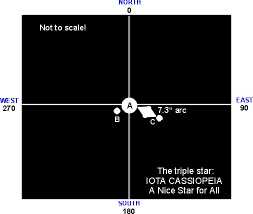
This finder/locator chart should serve as your invitation to check out one of the nicest multiple star systems for small, medium and large amateur telescopes. Iota Cas is a true physical triple system. The primary star is a very yellow-white magnitude 4.7; there are two companions to this star, a clearly blue one ("B") only 2.3" arc away (easily resolvable at high magnification - about 25x per inch)a t magnitude 7.0 at position angle 240 degrees (nearly due west) and a very RED fainter companion ("C", magnitude 8.2) some 7" arc nearly opposite the brighter star from "B". All three stars are bright enough to see clearly in small telescopes, but a steady night at least the ETX 90 is required to split the "A" and "B" components; the "C" star should be relatively easy in the ETX 60/70, although "B" may not be seen at any power. Give it a try!
Note that "B" requires about 840 years to orbit the primary as seen from Earth; "C"'s period is still undetermined, but best estimates give an orbital period of greater than 4,000 years!
Object 4 - A Test Object for the LX 8" and Larger Telescopes - Lambda Cassiopeia
Here is a toughie for the LX 90 and larger telescopes. This double star will require pretty high magnification (about 320x) and very steady skies when Lambda is nearly overhead, or highest in the sky. This double is a VERY blue hot pair of equally matched stars, magnitudes 5.5 and 5.8 visually. They are separated ONLY by 0.5" arc and quite a test for larger amateur telescopes. Because of the brightness of this pair, they should be easy to locate and recognize at low power; then begin moving up in magnification to over 300x (or whatever it takes!) to show some dark sky between them. I have split them with difficulty with the LX 90, (well collimated and a very steady, foggy night!) and pretty easily repeatedly with a 12" Schmidt-Cassegrain. My 6" Unitron showed these stars as elongated, but not cleanly separated at any power. Look for the stars in an almost NORTH-SOUTH orientation from one-another.
Object 5 - Great Double Star - Sigma Cas
This is a pair of stars that deserve observing with the ETX 90 and larger scopes. The primary is magnitude 5.5 while the fainter companion is 7.5 in Position Angle 326 degrees (almost in a north-south orientation). These very blue-white young stars are separated by 3.0" arc, so they are clearly resolvable in the 3" scopes with medium (about 150x) magnification.
Object 6 - A Classic Long Period Variable Star - R Cassiopeia
Here is a very nice variable stars, one of the finest long-period variables (LPV) in the sky. R Cas will go from a bright naked eye 5.4 magnitude (easily observable when at its brightest phases in all telescopes!) to a dim magnitude 13, still attainable in the ETX 125 and even with a 3.5" scope for the keen eyed! The light changes from brightest to brightest again require a total period of 431 days, so this is a long-term (more than one year!) project if you choose to follow this star's changes and chart your own light curve. The curve shown below is from estimates of observers in the American Association of Variable Star Observers (AAVSO - www.aavso.org) over many years of observing.
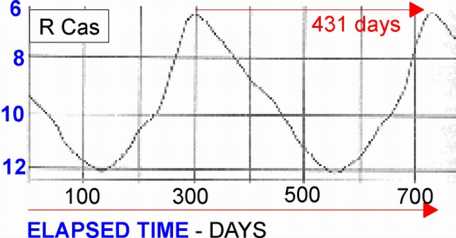
Since the light changes so slowly as this huge star pulses out (from thermal pressure) and inward (from gravity), that observations should not be made but every two weeks or so....over-observing usually leads to spurious brightening or changes that you record that "really" don't exist! When the star is at its brightest, you want to use the "locator" chart from the AAVSO, chart "A", available for free downloading at http://www.aavso.org/vsp (enter "r cas" for the name).
As it dims below 9th magnitude, be sure an move up in your chart to the narrow field, high power "C" chart which gives accurate comparison magnitudes for very faint nearby stars with which to compare. This chart is also available at http://www.aavso.org/vsp (enter "r cas" for the name).
Merely right click on the chart and save it to file on your computer; call up the file and resize it to fit your standard 8.5 x 11 inch paper size and re-save in that new format. Then simply print out each of these charts, laminate for outdoor use and observe away! (see my complete discussion on variable stars at: http://www.weasner.com/etx/ref_guides/variable_stars.html )
Object 7 - A Jewel Box of the Sky...Messier 52....Splendid Open Galactic Cluster
Just looking at the beautiful Lowell Observatory photography of Messier 52 below reminds me of sparkling diamonds scattered onto a black velvet mat....some larger and more brilliant than others, but all necessary to make this splendid sight what it is.
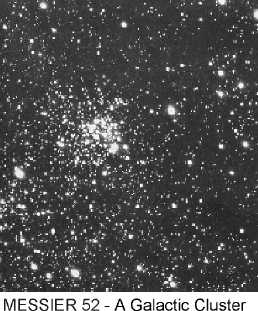
Messier 52 is located in the extremely star-rich arms of the winter/fall Milky Way, home of many such clusters nearby. The British Admiral Smyth recorded his impressions of the cluster as an irregular patch of stars that reminded him of a bird in flight, wings outstretched! Near one of the "apex" points of this triangular deep sky object is a wonderful orange-red star that is clearly a contrasting color to the remaining 120 stars, all in the 10th magnitude range. Note that in the western part of the cluster are two more brighter stars as well as one single brighter star on the opposite (eastern) side. This is a very compact but fairly large (12' arc) cluster that can be seen even in binoculars or your finder as a fuzzy patch (magnitude 7.3). By all means observe this cluster ONLY with a wide field and low magnification for your best views.
Even as I write this I have just come in from an early morning "test" of various telescopes on this cluster. It is an interesting object. With the 24" scope, the cluster is not at all impressive and looses its true cluster form in the narrow field of view. A 10" Schmidt-Cass shows the entire cluster very well at low power, but it appears large and scattered, much as it does in the LX 90 8"; the ETX 125 5" scope shows it perhaps better than all others, with all stars being visible that are in other larger scope, but with a brightness and image scale that is much more appealing to the eye! Thus, if you are using a 3" to 6" telescope, this cluster will become one of your all-time favorites!
Object 8 - Another Beautiful Galactic Cluster - NGC 663 (and nearby ngc654)
Here is a double treat! NGC 663, at magnitude 7.1 is a fairly large (11' arc) round conglomeration of about 60 stars; some of the group are fairly bright (8-9 magnitude), and the entire cluster is a beautiful sight in low power views of all telescopes; it is particularly pleasing and rich with very faint stars in the 5" and 8" scopes. Just to its north is a much less populated cluster, and about half the size, ngc654, which has some 50 stars of about the 11th magnitude. This latter cluster is a nice object - and challenging - for the ETX 90 scope and is quite a nice sight in the 5". If using a very wide field eyepiece, you can get both these objects in the same field of view (this makes a beautiful grouping in the ETX 60/70 scopes!), with ngc654 about 1/2 degree NORTH and slightly to the east of ngc663. This pair is well shown in the wide-field photograph courtesy of Lowell Observatory's 13" sky camera.
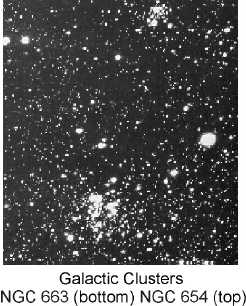
Object 9 - Another Galactic Star Cluster - NGC 457
This is a fantastic object often overlooked by amateurs, located about 4 degrees from "the middle of the 'W'" asterism of Cassiopeia. NGC 457 contains over 100 stars, all of which are discernible to the ETX 125 and larger scopes. Even the 3" can make out many of the beautifully faint individual stars as the "twinkle" in and out of visibility, just at the threshold of your limiting magnitude.
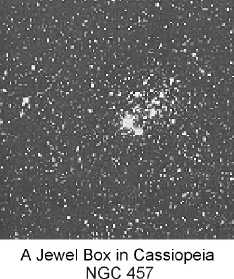
As seen in my photograph, there is a brighter star, magnitude 7.2, just on the southern edge of this cluster. This yellowish star is actually a member of the cluster and NOT a foreground object as seen in so many clusters containing seemingly brighter members. With a total integrated magnitude of 7.4 visually, this cluster is visible as a bright "smudge" in the ETX 60/70 scopes and with partial resolution in the 90. It is a wonderful sight in the 8" scope, fairly large and uniformly filled with very faint stars except for the two bright stars in its southeastern quadrant.
Object 10 - Galactic Cluster NGC 7789
Here is a beautiful object for the 3" and larger scopes; even the ETX 60 will clearly show this cluster as a very faint patch of "star dust" between the bright stars Rho and Sigma Cas. As you increase aperture, the more stars that are visible....indeed, up to 1,000 stars exist within the gravitational bounds of this remarkable and distant (6,000 light years!) object. This is a very rare and unusual galactic cluster. has recently been found that this is one of the OLDEST ones known.....nearly 2 billion years old....older than most, but not nearly as old as the "globular star clusters" (see my article on globulars at: http://www.weasner.com/etx/ref_guides/globulars.html ). Thus there is some discussion as to whether this might be a very "young" and sparse globular, or a very old open cluster.... NGC 7789 is about the apparent size (30' arc) as the full moon, so it requires a wide field of view and VERY dark skies to appreciate its splendor! (photo below courtesy Lowell Observatory)
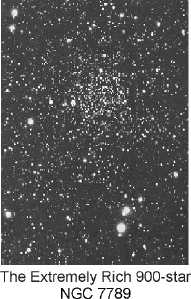
OBJECT 11 - A "non-Messier (?)" Messier Object! - Messier 103
There is much disagreement as to whether this very small (5' arc) and sparse (about 60 stars) was actually included by Charles Messier in his original list of "faint fuzzies" that he compiled to prevent confusion in his search for new comets. Most agree that Messier recorded (not "found"....most, if not all, of the "M-objects" were known long before Messier ever began his illustrious career as a comet hound) a total of 104 objects, but two are uncertain as to whether they were actually the RIGHT objects on his list. Messier 103 (ngc581) seems to be the actual FINAL M-object, while Messier 104 (the Sombrero galaxy) has been added in more recent times. Messier 103 is in the same very wide field of view as Delta Cas (RUCHBAH), some one degree southwest away. There are four brighter stars (at least 9th magnitude) that should be visible in the 3" scope against the fuzzy faint glow of the remaining four dozen or so stars. BE SURE and look for the scarlet-colored very red (9th magnitude) and blue (mag. 6.2) double star (Struve 131) embedded directly in this nice cluster! The two stars are a wonderful color contrast and are separated by a full 14" arc, so it should be an easy object, both in terms of separation and in magnitude for all scopes at medium-high (about 25x per inch) magnification.
OBJECT 12 - Elliptical Galaxies - NGC 185 / 147- Companions to Famous Andromeda Galaxy
Like ngc105 and Messier 32, ngc185 & 147 are gravitational partners to the famous Andromeda Galaxy, Messier 31 (see: http://www.weasner.com/etx/ref_guides/andromeda.html ). When you compare this map to the proximity of Andromeda, you will see how that is indeed possible; all these as well as the Milky Way and a few others comprise what is known to astronomers as the "Local Group", a gravitationally-bound cluster of galaxies in this "neck of the Universe."
Look for ngc185 as a VERY faint (magnitude 11.0), 2.2' arc round glow in a very low, wide-field eyepiece, just barely discernable from an out-of-focus star; this can be seen barely with the ETX 90 and with difficulty in the 5" scope. Off to the north, and a little west of this one (about 50' arc total) you will see an even fainter galaxy (147) at magnitude 12, just at the threshold of the 5" scope....the 8" and larger are really needed, but to get them both in the field of view will require the 32mm 2" Super Wide Angle or similar. Do not expect to see ANY detail in even large amateur telescopes, and resolution is only accomplished photographically with scopes over 100" diameter!
----------------------------------
WANDERING ABOUT....YOUR NEW "USER OBJECT" IN CASSIOPEIA
You are about to key in an object into your USER OBJECT LIBRARY that you: 1) did not see; 2) will not see now; and, 3) likely NEVER will see....but it IS worth putting in your library nonetheless. Refer to the chart below (north at top, east at the right, just as with your catadioptic telescope with the diagonal mirror/prism in place) to locate what you cannot see:
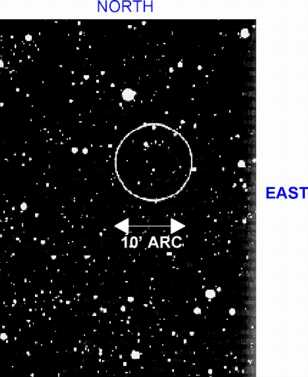
In the year 1572, a star exploded in the sky - a "supernova" - that filled our Milky Way galaxy with light; from Earth, it was brighter than even the brilliant planet Venus, and nearly that of the quarter moon. It is one of only four know (since recorded history, at least) supernovae to have occurred in our galaxy. Although not first "discovered" by Tycho Brahe, he was the first to measure and carefully record its brightness and coordinates on November 11 in 1572. He noted that for over two weeks, the "new star" had been seen in mid-day, and remained visible to the naked eye for over 16 months! But....no matter how bright this star WAS, there is no trace of it today. Only scant traces of a nebulous cloud can be seen with the world's giant telescopes....no star is left brighter than around 20th magnitude.
Nonetheless, you can point out this special place in the sky where the GREATEST EXPLOSION in all of recorded history was observed over 400 years ago. The coordinates of "TYCHO'S STAR" are: Right Ascension: 00h 22.0m ; Declination: + 63 degrees 52 minutes. The center of the white circle indicates the position accurately. This is not only a part of the sky that you should observe in a rather "humbling way," but also one that is a terrific "talking point" at any star party or club outing!
On AutoStar, go to: "Select/Object [enter]...." scroll down to "User Object" [ enter]. Now enter the coordinates given above for "Tychos", using the number keys on AutoStar. After entering the coordinates and pressing "Enter" yet again, scroll down one and you can list the magnitude of the object as "20"[Enter].
Next Constellation GO TO" TOUR Installment: It's a ZOO out there! We had whales, dolphins, fish and even flying horses....so what's a little GIRAFFE going to hurt? That's right: next installment of our computerized telescope "GO TO" TOURS Guides to the Constellations we will take a look inside (figuratively, thank goodness!) CAMELOPARDALIS, the night's sky's long-necked spotted furry friend. Why a giraffe in the sky, you ask? Me too....
Nonetheless, we will explore this often-overlooked constellation without nary a named star nor Messier object, but having a few worthy galaxies and some very nice and challenging double/multiple stars! In addition, this constellation offers a couple of "all night observable" variable stars since it - just like Cassiopeia - is circumpolar from northern latitudes, meaning that it encircles the north celestial pole never rising nor setting throughout the 24-hour day.
Good Observing and may the stars serve as your sentries as you explore the frontiers of space!
P. Clay Sherrod
Arkansas Sky Observatory
Conway / Petit Jean Mountain
Arkansas
Go to the Observational Guides & References page.
Go to the ETX Site.
Go to Cassiopeia Observatory site.